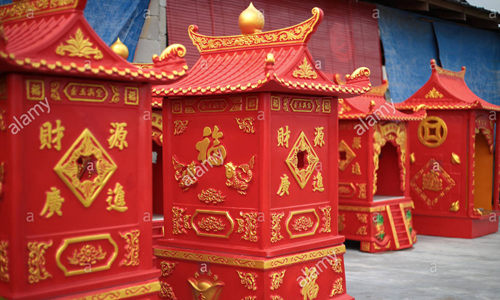Rina Banerjee’s work is a melange upon a melange of images, ideas, and information existing in contrast to the fact that we can never know everything.
PHILADELPHIA — Rina Banerjee’s Make Me a Summary of the World at the Pennsylvania Academy of Fine Arts exudes a sense of calm that comes to those who have wrestled with hard subjects for a long time. Form and function are inextricably bound for Banerjee, with all of her major themes grounded in distinct physical materials.
In a series of short videos on the exhibition’s first floor, Banerjee describes her interest in plastic, as well as a few other materials she commonly uses. She is drawn to the beauty of plastic, she says, because “it can look like many things.” “Take me, take me, take me to the Palace of love” (2003), an 18-foot recreation of the Taj Mahal, is certainly proof of this. The walls of this large sculptural work, which re-imagines the original building in Agra, India, consist of red cellophane sheeting, supported by a metal frame suspended from the ceiling. It hangs one foot off the ground and is big enough for visitors to walk inside. Banerjee has repurposed plastic, which most of us would see as unfortunate waste, for a serious work of art.
Banerjee chose red cellophane for “Take me, take me” in order to challenge Victorian customs, like those of weddings, that are still with us today. As she describes in a statement for PAFA, ” … weddings only became white weddings because of Queen Victoria. It’s Victorian modesty to not have color and in Indian tradition, a widow would not have color in their clothes.” The original Taj Mahal, recognized as one of the Wonders of the World, is made from ivory-white marble. The Mughal emperor, Shah Jahan, commissioned the building for his wife, Mumtaz Mahal, as a tomb. Bannerjee’s work playfully subverts both Victorian and Indian traditional views by using red, the color of passion.
For those familiar with PAFA’s two exhibition buildings, you might expect the exhibition to be in the more modern Hamilton building. But part of its energy comes from its placement in the Historic Landmark Building, the original museum building, completed in 1876 and designed by Frank Furness and George Hewitt. Because Banerjee’s work is so deeply anthropological, situating it among the traditional portraiture and landscapes that built PAFA’s reputation as one of the country’s preeminent institutions for instilling traditional methods of art-making in its students is a masterstroke.
Nearly all of the subjects in the traditional portraits hail from powerful colonial families. Among them is Rembrandt Peale’s “George Washington, Patriae Pater” (1824). Banerjee’s work, thankfully, fumigates the room of its pretension. The artist reminds us that these people of enormous wealth and power used “the arm of empire to retrieve the pearl from the oyster,” as she states in another video included in the show.
Banerjee has a poet’s sense of how to use language in her work, as this exhibition’s title demonstrates. While the title commands the audience to make a summary of the world, it also seems to urge the viewer to turn Banerjee into a summary of the world, as if she could embody everything. Both tasks are impossible.
The language of her titles is rich and evocative. One 2017 sculpture, abundant with oyster shells, is perhaps the most striking in the show. I trust you will have read nothing like this title before on a museum wall:
Viola, from New Orleans-ah, an African Woman, was the 19th century’s rescue worker, a global business goods raker, combed, tilled the land of Commerce, giving America a certain extra extra excess culture, to cultivate it, making home for aliens not registered, made business of the finer, finer, had occupations, darning thread not leisure with reason and with luster in “peek a boo” racial disguises preoccupied in circulating commerce, entertaining white folks, pulling and punching holes in barriers, place that where was once barren, without them, white banks made of mustard and made friendly folks feel home, welcomed and married immigrants from far noted how they been also starved, fled from servitude and colonial dangers, ships like dungeons, pushing coal in termite wholes, churning fire, but always learning, folding, washing, welcomed as aliens. She wandering, hosting, raising children connected to new mobilities and most unusual these movements in Treme’, New Orleans was a incubating, enmeshed embedded in this silken cocoon when she land, she’s came to be parachute mender, landed those black immigrant peddlers from Hoogali network of new comers
If you skimmed any of that title, I urge you to take it from top. The language is not merely descriptive. It moves with the rhythm of demotic speech and reveals the layers that comprise Viola’s history. The dominant undercurrent is immigration, which Banerjee’s work consistently addresses. Elsewhere in the show, she declares immigration is not an “infection.” Part of what is fascinating about Banerjee is her ability to tackle fraught political issues without coming across as didactic. She is an artist identifying and developing a method for depicting a problem, not an ideologue making one-dimensional art.
“Viola” is a 21st-century version of Pythocritos’s “Winged Victory of Samothrace” (190 B.C. E.), displayed prominently at the Louvre. This reference to ancient Greece is compelling given the history of invasions into South Asia begun by Alexander the Great in 327 B.C.E. These conquests failed to yield the power that Alexander sought, but they established trade connections and influenced cultural production for several generations.
“Winged Victory” is often viewed as a model of form and movement; Banerjee’s “Viola” ups the ante several fold. One of the focal points in her sculpture is a Yoruba African mask, with two bright metal disks, and flowing Korean and Indian silks on either side of the mask. Rather than a solid marble foundation, as in the Hellenistic work, the artist fabricated a thick steel frame for a torso. From the front, it’s difficult to recognize this foundation as a body. From behind, the ribs are exposed and the skull is framed by sturdy wire mesh. The feet are made from two Indian rakes. Oyster shells cover the floor.
Banerjee’s methods of characterization for Viola’s layers of self are stunning enough. But she adds another physical dimension to her work, running a cluster of long, cobweb-like strings from the spinal column diagonally up towards the ceiling. The strings are so still that I could feel my breath slowing down. About halfway up these strings is a French wire Ferris wheel, while at the upper end is what looks like an old chandelier suspended from the high ceiling above the staircase. Throughout the exhibition I sensed a devotional energy, in service to the work and the issues.
The exhibition also includes examples of Banerjee’s impressively titled paintings. “The Intellectual Explorer as a Underdeveloped Two Headed Man Pillaged and Parroted the Dreams of Natives. His Fruit Was an Individual Identity” (2008), a work in ink, acrylic, and enamel paint on paper, depicts two heads with tongues lashing as they emerge from a small mass of light blue and yellow swirls. Large orange drops fall like rain. Without the title this painting would appear to be a rendering of Janus, the Roman god of transitions who looks to the future and to the past — except, in Banerjee’s case, the faces most likely look to the East and the West. Similarly, the painting seems to address the notion of being “Janus-faced,” as in “two-faced,” particularly in the context of politics. But the language in Banerjee’s title clarifies a point she addresses throughout her work: the pearls an empire seeks are not only natural resources, such as sugar or tea. Empires also pillage ideas and identities.
As I wrote this review, I kept returning to the exhibition title, Make Me a Summary of the World. Many of the works in this exhibition resist summarization. How do I describe “Viola”? I found that I couldn’t, not in any satisfying way. Part of the problem with summarization is that something is always left out. In this way, Banerjee’s work signifies, for me, what it means to be contemporary: a melange upon a melange of images, ideas, and information existing in contrast to the fact that we can never know everything. Banerjee’s work offers some summaries of this world in which we live. I would take hers any day, where there’s more truth than fiction.
Source : hyperallergic.com








